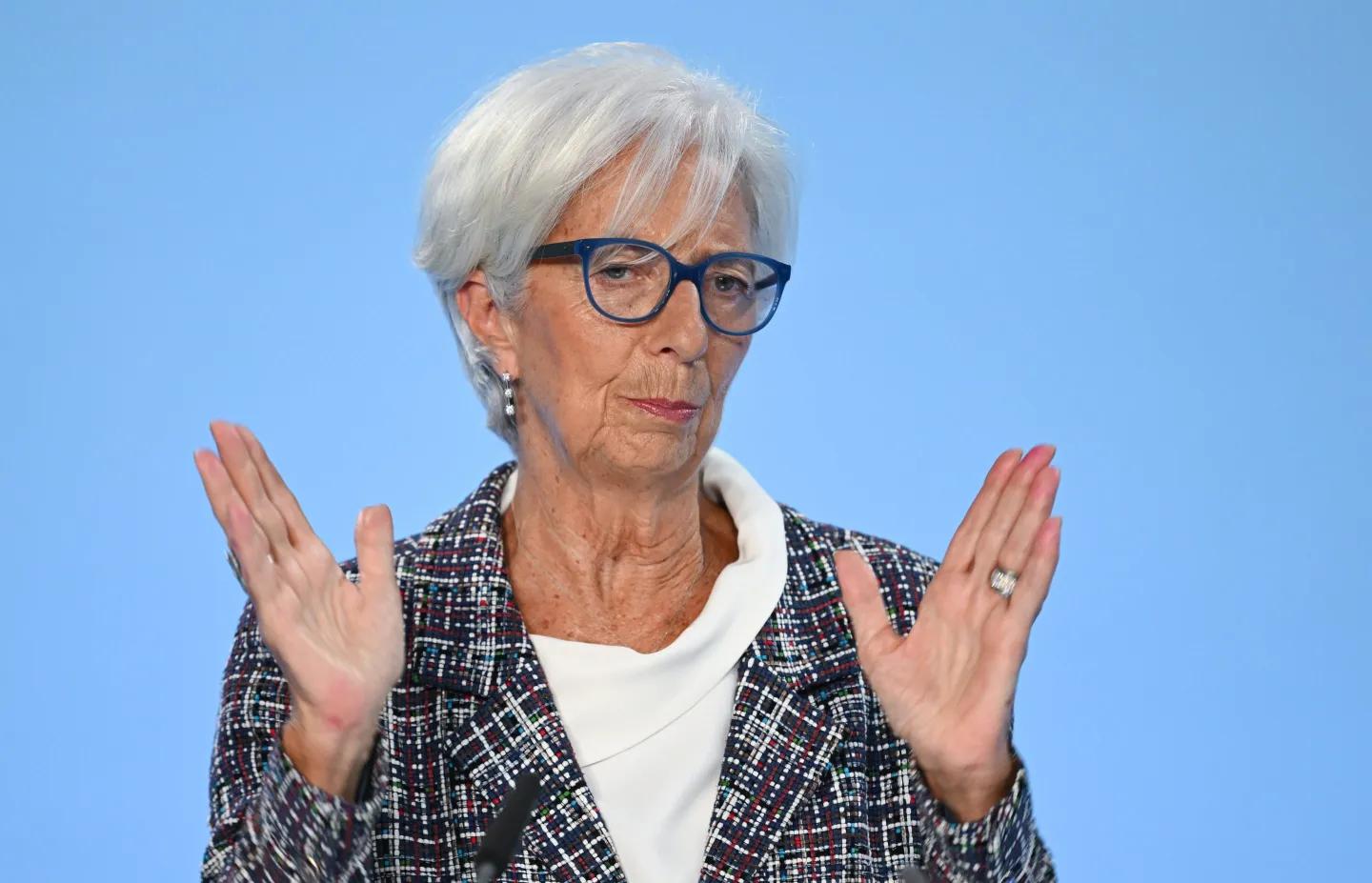
7月,欧元区二十国的通胀增至2.6%,依然顽固地高于欧洲央行目标值,也使得欧洲央行(European Central Bank)是否通过降息来促增长的下一步决策变得复杂化,而欧洲经济在经历了漫长的停滞之后亦未能呈现令人信服的复苏。
欧盟统计机构欧盟统计局(Eurostat)周三发布的官方数据显示,通胀较6月的2.5%有所上扬。欧洲央行密切关注的数据——服务业通胀率,依然处于的4.0%的高位,较之前的4.1%有所回落。
通胀的上扬将激化人们对欧洲央行9月12日会议下一步决策的讨论。这家针对欧元区国家的央行在6月份进行了首次试探性利率下调,将其基准利率降至3.75%,降幅25个基点。这家央行的理事会随后在7月的会议中叫停了降息,欧洲央行行长克里斯蒂娜•拉加德称,央行将根据有关通胀和经济表现的最新数据,通过每一次会议来制定下一步举措。
欧洲央行与包括美联储在内的其他央行迅速提升利率,以应对俄乌战争、能源价格高企以及疫情后经济的突发反弹所导致的通胀。疫情期间,零部件和原材料供应受到了限制。在俄罗斯切断了大部分天然气供应之后,欧洲受到的冲击尤为严重。
能源价格有所回落,通胀如今也从2022年10月10.6%的峰值有所下降。然而,通胀已经影响到薪资以及服务行业价格,后者包括广泛的门类,例如医疗、影票价格、餐厅菜价、酒店房价和美容院价格。受此影响,整体通胀率依然在2%-3%之间徘徊,高于欧洲央行2%的目标值,也就是业界认为的最有利于经济的通胀水平。
在召开下一次会议之前,欧洲央行将拿到8月份的数据并对其进行解读。欧洲央行官员称,他们预计下半年通胀将围绕当前水平波动,并在2025年底下滑至其目标值。
美联储官员正在权衡降息时间,其当前的峰值基准利率范围为5.25%-5.5%。同时,美联储可能会通过即将于周三结束的会议来确定9月利率的走向。美国6月的年通胀率为3.0%。
加息会提升购物的信贷成本,减缓商品需求以及缓解价格压力,从而以此来应对通胀。然而,更高的利率会抑制增长,而且欧洲最近的经济数据毫无起色,同时,在经历了一年多近乎零增长之后,欧洲也未能呈现令人信服的复苏。
欧洲GDP今年前两个季度的增幅均为0.3%,与此前近零增长或负增长相比已是连续5个季度有所好转。然而最近,包括标准普尔全球采购经理人指数(S&P Global’s purchasing managers’ index)在内的未来经济活动指标,认为欧洲经济依然没有什么起色。不过,其中一个助力是劳动力市场,失业率依然处于6.4%的低位。(财富中文网)
译者:冯丰
审校:夏林
7月,欧元区二十国的通胀增至2.6%,依然顽固地高于欧洲央行目标值,也使得欧洲央行(European Central Bank)是否通过降息来促增长的下一步决策变得复杂化,而欧洲经济在经历了漫长的停滞之后亦未能呈现令人信服的复苏。
欧盟统计机构欧盟统计局(Eurostat)周三发布的官方数据显示,通胀较6月的2.5%有所上扬。欧洲央行密切关注的数据——服务业通胀率,依然处于的4.0%的高位,较之前的4.1%有所回落。
通胀的上扬将激化人们对欧洲央行9月12日会议下一步决策的讨论。这家针对欧元区国家的央行在6月份进行了首次试探性利率下调,将其基准利率降至3.75%,降幅25个基点。这家央行的理事会随后在7月的会议中叫停了降息,欧洲央行行长克里斯蒂娜•拉加德称,央行将根据有关通胀和经济表现的最新数据,通过每一次会议来制定下一步举措。
欧洲央行与包括美联储在内的其他央行迅速提升利率,以应对俄乌战争、能源价格高企以及疫情后经济的突发反弹所导致的通胀。疫情期间,零部件和原材料供应受到了限制。在俄罗斯切断了大部分天然气供应之后,欧洲受到的冲击尤为严重。
能源价格有所回落,通胀如今也从2022年10月10.6%的峰值有所下降。然而,通胀已经影响到薪资以及服务行业价格,后者包括广泛的门类,例如医疗、影票价格、餐厅菜价、酒店房价和美容院价格。受此影响,整体通胀率依然在2%-3%之间徘徊,高于欧洲央行2%的目标值,也就是业界认为的最有利于经济的通胀水平。
在召开下一次会议之前,欧洲央行将拿到8月份的数据并对其进行解读。欧洲央行官员称,他们预计下半年通胀将围绕当前水平波动,并在2025年底下滑至其目标值。
美联储官员正在权衡降息时间,其当前的峰值基准利率范围为5.25%-5.5%。同时,美联储可能会通过即将于周三结束的会议来确定9月利率的走向。美国6月的年通胀率为3.0%。
加息会提升购物的信贷成本,减缓商品需求以及缓解价格压力,从而以此来应对通胀。然而,更高的利率会抑制增长,而且欧洲最近的经济数据毫无起色,同时,在经历了一年多近乎零增长之后,欧洲也未能呈现令人信服的复苏。
欧洲GDP今年前两个季度的增幅均为0.3%,与此前近零增长或负增长相比已是连续5个季度有所好转。然而最近,包括标准普尔全球采购经理人指数(S&P Global’s purchasing managers’ index)在内的未来经济活动指标,认为欧洲经济依然没有什么起色。不过,其中一个助力是劳动力市场,失业率依然处于6.4%的低位。(财富中文网)
译者:冯丰
审校:夏林
Christine Lagarde, President of the European Central Bank.
Inflation in the 20 countries that use the euro ticked up to 2.6% in July, stubbornly above the European Central Bank’s target and complicating the ECB’s next decision on whether to cut interest rates and boost growth as the economy struggles to stage a convincing recovery after a long stretch of stagnation.
Inflation rose from 2.5% in June, according to official figures Wednesday from the EU statistics agency Eurostat. Services inflation, a figure closely watched by the ECB, remained elevated at 4.0%, down from 4.1%.
The uptick will intensify discussions around the ECB’s next move at its Sept. 12 meeting. The central bank for the eurozone countries made a first tentative interest rate cut in June, lowering its benchmark rate by a quarter percentage point to 3.75%. The bank’s governing council then hit pause at the July meeting, with ECB President Christine Lagarde saying the bank would take its next decisions meeting by meeting based on incoming data about inflation and the economy’s performance.
The ECB along with other central banks including the U.S. Federal Reserve rapidly raised interest rates to combat a spike in inflation sparked by Russia’s invasion of Ukraine and higher energy prices as well as by the sudden rebound of the economy after the pandemic, which strained supplies of parts and raw materials. Europe in particular was hit by higher energy prices after Russia cut off most supplies of natural gas.
Energy prices have fallen and inflation is now down from its peak of 10.6% in October 2022. However, inflation has spread to wages and to services’ prices, a broad category including medical care, theater tickets, restaurant meals, hotel rooms and beauty salons’ prices. As a result, overall inflation has remained stuck between 2% and 3%, short of the ECB’s target of 2% which is considered best for the economy.
The ECB will have another inflation reading from August to digest by the time of its next meeting. Bank officials say they expect inflation to fluctuate around current levels for the rest of the year and to decline to reach their goal by the end of 2025.
Officials at the U.S. Federal Reserve are weighing the timing of a first cut from the current peak of 5.25%-5.5% benchmark range and may use their meeting ending Wednesday to set up a September rate move. U.S. annual inflation was 3.0% in June.
Rate hikes combat inflation by raising the cost of credit for buying things, cooling demand for goods and taking the pressure off prices. But higher rates can hurt growth, and recent economic data have been downbeat as Europe struggles to show a convincing recovery after more than a year of near-zero growth figures.
Gross domestic product rose 0.3% in each of the first two quarters of this year, an improvement on five straight quarters of readings at near-zero or below. But recent indicators of economic activity going forward, such as S&P Global’s purchasing managers’ index, suggest that the economy is still barely growing. One source of strength is the labor market; unemployment remains low at 6.4%.






